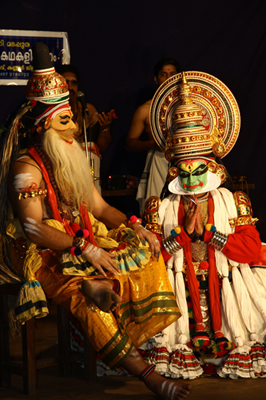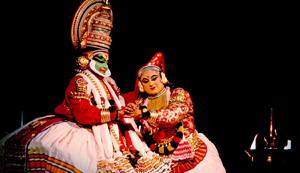Thai Resort Booking is possible only by contacting us directly & limited only through our website www.thairesort.in (We are not appointed any third party person or third party website for Thai Resort Booking)
"This is a great little hotel with a near perfect location if you are visiting Parassinikadavu Sree Muthappan Temple. Nice facilities…lovely atmosphere…wonderful value. What more can one asks?"
- Mr.Yokesya.
Kathakali
 Popular belief is that Kathakali is emerged from "Krishnanattam", the dance drama on the life and activities of Lord Krishna created by Sri Manavedan Raja, the Zamorin of Calicut (1585-1658 AD). Once Kottarakkara Thampuran, the Raja of Kottarakkara who was attracted by Krishnanattam requested the Zamorin for the loan of a troupe of performers. Due to the political rivalry between the two, Zamorin did not allow this. So Kottarakkara Thampuran created another art form called Ramanattam which was later transformed into Aattakatha. Krishnanaattam was written in Sanskrit, and Ramanattam was in Malayalam. By the end of 17th century, Attakatha was presented to the world with the title 'Kathakali'.
Popular belief is that Kathakali is emerged from "Krishnanattam", the dance drama on the life and activities of Lord Krishna created by Sri Manavedan Raja, the Zamorin of Calicut (1585-1658 AD). Once Kottarakkara Thampuran, the Raja of Kottarakkara who was attracted by Krishnanattam requested the Zamorin for the loan of a troupe of performers. Due to the political rivalry between the two, Zamorin did not allow this. So Kottarakkara Thampuran created another art form called Ramanattam which was later transformed into Aattakatha. Krishnanaattam was written in Sanskrit, and Ramanattam was in Malayalam. By the end of 17th century, Attakatha was presented to the world with the title 'Kathakali'.
Ignoring the first phase when it was Ramanattam, Kathakali had its cradle in Vettattnad. Here Vettathu Thampuran, Kottayathu Thampuran and many dedicated artists like Chathu Panicker laid foundations for what is known as Kathakali now. Their efforts were concentrated on the rituals, classical details and scriptural perfection. Kottayathu Thampuran composed four great works -- Kirmeeravadham, Bakavadham, Nivathakavacha Kalakeyavadham and Kalyanasaugandhikam. After this the most important changes in Kathakali were brought about through the efforts of a single person namely, Kaplingad Narayanan Nambudiri (1739–1789). He was from the Northern Kerala, but after basic instructions in various faculties of the art in Vettathu Kalari he shifted to Travancore. In the capital and many other centres he found many willing to co-operate with him in bringing about the reformations.
Kathakali also shares a lot of similarities with Krishnanattam, Koodiyattam (a classical Sanskrit drama existing in Kerala) and Ashtapadiyattam (an adaptation of 12th-century musical called Gitagovindam). It also incorporates several other  elements from traditional and ritualistic art forms like Mudiyettu, Thiyyattu, Theyyam and Padayani besides a minor share of folk arts like Porattunatakam. All along, the martial art of Kalarippayattu has influenced the body language of Kathakali. The use of Malayalam, the local language (albeit as a mix of Sanskrit and Malayalam, has also helped the literature of Kathakali sound more transparent for the average audience.
elements from traditional and ritualistic art forms like Mudiyettu, Thiyyattu, Theyyam and Padayani besides a minor share of folk arts like Porattunatakam. All along, the martial art of Kalarippayattu has influenced the body language of Kathakali. The use of Malayalam, the local language (albeit as a mix of Sanskrit and Malayalam, has also helped the literature of Kathakali sound more transparent for the average audience.
